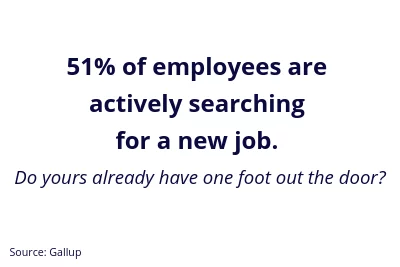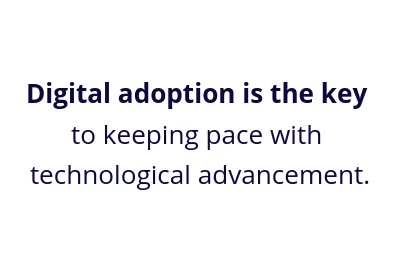Sinking economic growth. Cyber threats. Barriers to trade. Stifling regulatory requirements. These are just some of the concerns swirling around the minds of company leaders. The list goes on.
There are many external factors that threaten business success, but CEOs must be vigilant against threats that increase vulnerability from within.
Some of the most menacing forces business leaders worry about are already inside: developing and retaining top talent and keeping up with the speed of disruptive technology. These findings come from PwC’s 22nd Annual CEO Survey and The Conference Board’s C-Suite Challenge 2019™, which polled 1,378 and 1,400 senior executives, respectively.
3 sources of executive worry and how to remedy them
Let’s take a deep dive into some of CEOs’ biggest worries in 2019, and what actions they can take to ensure the best results.
1. Availability of key skills
Acquiring desired skills is one of the most immediate concerns for CEOs across the globe. Today, when volatile markets and accelerating digital progress drive constant change, broadening the skill sets that enable your organization to evolve and compete is paramount to success.
Dive Deeper: How to Master Digital Change and Dominate the Competition
According to research from McKinsey, companies are most concerned with finding workers with advanced IT and 
While advanced programming capabilities will always be sought after, many companies even lack enough employees with basic digital skills. Need for elementary digital skills is expected to increase by 69% over the same time period.
Soft skills — such as communication, creativity, problem-solving, and emotional intelligence — are also in demand. The same McKinsey report predicts companies across all industries will seek these skills 26% more through 2030.
Be smart: Clarify skills needs in recruitment and training
The best way to increase access to important skills is to address them in your strategies for recruiting new talent and developing your current workforce.
For this, you will need close alignment with your human resources department. Your HR leaders and training managers have the closest look into your current practices for vetting candidates, new-hire onboarding, and ongoing employee development. By partnering with them, you can work together to refine these practices and acquire the needed skills.
It’s important to find the right balance between hiring new talent with the desired skills and retraining your current employees.
While adding staff who possess the relevant experience and skills can be helpful, exclusively focusing on recruiting is not sustainable in terms of dollars and time. Instead, paying greater attention to the methods with which you train your current workforce can yield the greatest results.
For example, your employees may have the aptitude to master a wide range of digital tools. They certainly have the desire, as the bulk of work is now performed on software platforms. But complex interfaces, non-intuitive UI, and frequent updates keep them from gaining proficiency. With a better software onboarding solution, all of these factors that keep your employees from enhancing their digital skills and performance disappear.
2. Retaining top talent
It’s a candidate’s market. As noted above, high-level digital skills, as well as soft skills, are in the greatest demand. For 
Keeping your top-tier employees engaged and productive is the ongoing challenge. How do you know your employees won’t abandon you for a competitor? What’s keeping them from doing so?
According to Gallup’s latest State of the American Workplace report, 51% of employees are actively looking for a new job or watching for openings. Another 68% of employees believe they are overqualified for their current role.
Be smart: Keep the employee experience front and center
Forget the big office parties, nap room, and even monetary bonuses. While these things can certainly have an effect on employee retention, broader factors like the overall employee experience have a much greater influence.
The employee experience is the sum of the perceptions employees have about their daily lives at work. The link between the employee experience and key metrics like retention, engagement, and performance is strong: better employee experience equals better outcomes across the board.
Everything from leadership transparency, the effectiveness of your managers, the physical office environment, the size and vibe within teams, volume of software systems, employee development opportunities, and more have a great impact on the employee experience.
By focusing on improving these factors, you can, in turn, keep your employees happier, more engaged, and most importantly, under your employment!
You might be wondering, How? The first and most simple step is to open channels of communication between employees and leadership that promote honest feedback — and actually do something about what they say.
3. The speed of technological change
Digital capabilities are constantly evolving. New, digitally-native companies are emerging all the time, creating new sources of competition. Today, CEOs are challeneged to not only keep pace with the accelerating pace of digital change, but to also build new business models based on them.
“The increasingly rapid rate of technological and digital advancement means that 21st century business leaders will need to reinvent their companies at a much faster pace than their predecessors and innovate to stay ahead of the curve.”
-Florian Smeritschnig, McKinsey
Advanced digital capabilities are at the core of any currently successful business model. Innovation is in their DNA. But how can traditional businesses develop these traits? How can new digital entrants sustain them after establishing their niche?
Be smart: Increase business agility and focus on digital adoption
Business leaders must focus on two key things in order to stay ahead of the tech curve: agility and adoption.
Being agile means having the flexibility to respond to external forces (such as market changes or new technological developments) without causing too much disruption. Business strategies that are agile are executed with considerable forethought, but they are not constrained by minute details — there’s wiggle room and opportunities for course correction as needed.
For instance, when agile organizations identified the potential for automation technology to improve operational efficiency and the customer experience, they reacted. They didn’t wait around for their competitors to implement this tech as they built a “perfect” strategy for it. Instead, they learned about its capabilities and limitations, determined where the opportunities were in their business model, and integrated the best possible tools.
Prioritizing digital adoption is another key to keeping up with new disruptive tech. Digital adoption means people can use technology for its intended purpose and to the fullest extent. It means maximizing all features and extracting the greatest possible value from your tech investment.
If you keep digital adoption at the top of your leadership agenda, you will also have a much easier time solving the first concern — acquiring key skills. With the right digital adoption strategy and tools, you can essentially guarantee your employees will have the needed digital skills.
WalkMe’s Digital Adoption Platform (DAP) transforms the user experience in today’s overwhelming digital world. Using artificial intelligence, engagement, guidance, and automation, WalkMe’s transparent overlay assists users to complete tasks easily within any enterprise software, mobile application or website. Discover how a DAP can revolutionize your business.


